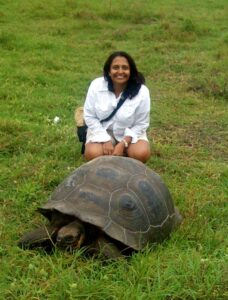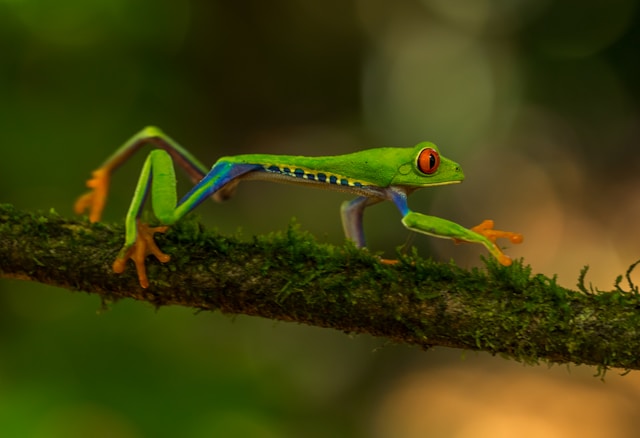Dr. Neeti Bathala is an ecologist and conservation biologist who will join Smithsonian students in Costa Rica this summer (on our second departure). Over her two decades of experience, she has spent time at numerous biological research stations in Costa Rica and has volunteered with sea turtle conservation efforts at Tortuguero National Park. We recently interviewed her to get to know her better, delving into her particular interests and hobbies, why she’s excited to work with Smithsonian students again this summer, and more.
What is your favorite book, movie, and/or tv show?
Rachel Carson, known for her impactful work like Silent Spring, also wrote three books on the sea—my favorite, The Sea Around Us, is a remarkable exploration of the ocean’s wonders, discussing its history, ecology, and the interconnectedness of life within it. TV shows like “Planet Earth,” and its counterpart “Ocean Planet,” offer stunning visuals and deep insights into the natural world, emphasizing the beauty and fragility of our planet’s ecosystems.
What is your favorite band or singer?
As a Jersey girl, Bruce Springsteen’s anthems resonate with me. Meanwhile, the Grateful Dead’s improvisational style and community-driven ethos is something I have been listening to and following for many decades.
What are your hobbies or passions outside of work?
My interests encompass cultivating gardens, advocating for coastal conservation, and exploring the underwater world through scuba diving.
What are you most excited for students to experience in Costa Rica this summer?
Exploring the biodiversity firsthand, engaging in hands-on conservation efforts like sea turtle protection, and exploring the country’s vibrant culture through local interactions and adventure activities.
What is the most significant challenge facing your field in the next five years?
In the field of conservation and environmental sustainability, one of the most significant challenges in the next five years is likely to be the urgency in addressing climate change. Finding effective and immediate solutions to mitigate its impacts, such as extreme weather events, rising sea levels, habitat loss, and biodiversity decline, will be crucial. Additionally, garnering global cooperation and commitment towards sustainable practices amidst socio-political complexities remains a pressing challenge for the field.
What is the most unexpected or surprising thing you have learned in your career?
In the field of ecology and teaching, one of the most unexpected yet fascinating revelations might be witnessing the interconnectedness of ecosystems and how small changes can have significant ripple effects.
What are the top three trends that will impact your industry in the next year?
The upcoming year will likely witness significant impacts in environmental science and ecology driven by advancements in technology, evolving climate policies, and a heightened focus on community engagement in conservation efforts.
What advice would you give to your high school self?
I’d advise my high school self to actively seek mentors and role models. Embrace curiosity, ask questions, and fearlessly explore various interests while seeking guidance from those who inspire and can offer valuable insights.
What is the biggest environmental challenge facing our planet right now, and what can we do about it?
One of the paramount environmental challenges today is climate change, impacting our planet through extreme weather, habitat loss, and biodiversity threats. To combat this, we must collectively transition to renewable energy sources, preserve and restore ecosystems, educate communities on sustainable practices, and invest in innovative solutions that reduce our environmental footprint. Collaboration is key!
If you could bring back one extinct species, which one would it be and why?
Bringing back a more recently extinct species, like the Tasmanian tiger (Thylacinus cynocephalus—not a true tiger, but a marsupial), could offer invaluable lessons in conservation. Studying the causes of their extinction and reintroducing them could highlight the importance of habitat preservation and the impact of human activity on biodiversity. It could also aid in understanding how to prevent similar extinctions and restore ecosystems more effectively.

What is the most surprising fact you’ve learned about a particular animal, plant or ecosystem?
One astonishing aspect of the rainforest ecosystem is the intricate relationship between trees and fungi. Trees communicate through an underground network of fungi called mycorrhizae. This mycorrhizal network allows trees to share nutrients, water, and even warnings about potential threats. It’s a fascinating form of interdependence, where different species collaborate to thrive, emphasizing the interconnectedness and complexity within ecosystems.
The coolest fact you know about coral reefs?
One of the most fascinating aspects of coral reefs is their incredible biodiversity. Although they cover only about 0.1% of the ocean floor, coral reefs are home to approximately 25% of all marine species. The intricate and colorful ecosystems created by coral colonies provide habitat and shelter for an astonishing array of marine life, making coral reefs one of the most diverse and vibrant ecosystems on Earth. They also play a crucial role in sustaining fisheries and protecting coastlines.
To learn more about our conservation program in Costa Rica, click here.

